Management Accounting: Principles, Techniques, and Integration Report
VerifiedAdded on 2023/06/04
|15
|4483
|332
Report
AI Summary
This report provides a comprehensive overview of management accounting, encompassing its principles, techniques, and practical applications. It begins by outlining the fundamental goals and principles of management accounting, emphasizing its role in decision-making and financial analysis. The report then delves into specific techniques, including absorption costing and marginal costing, with detailed income statements and a reconciliation statement demonstrating the differences between the two methods. Furthermore, the report examines the integration of management accounting within an organization, highlighting the benefits it provides, such as improved inventory management, cost control, and resource allocation. The report also includes a statement of cash flows to provide a comprehensive financial analysis. Through this exploration, the report underscores the importance of management accounting in supporting effective business strategies and sustainable success. The report is available on Desklib, a platform offering AI-powered study tools and past papers.
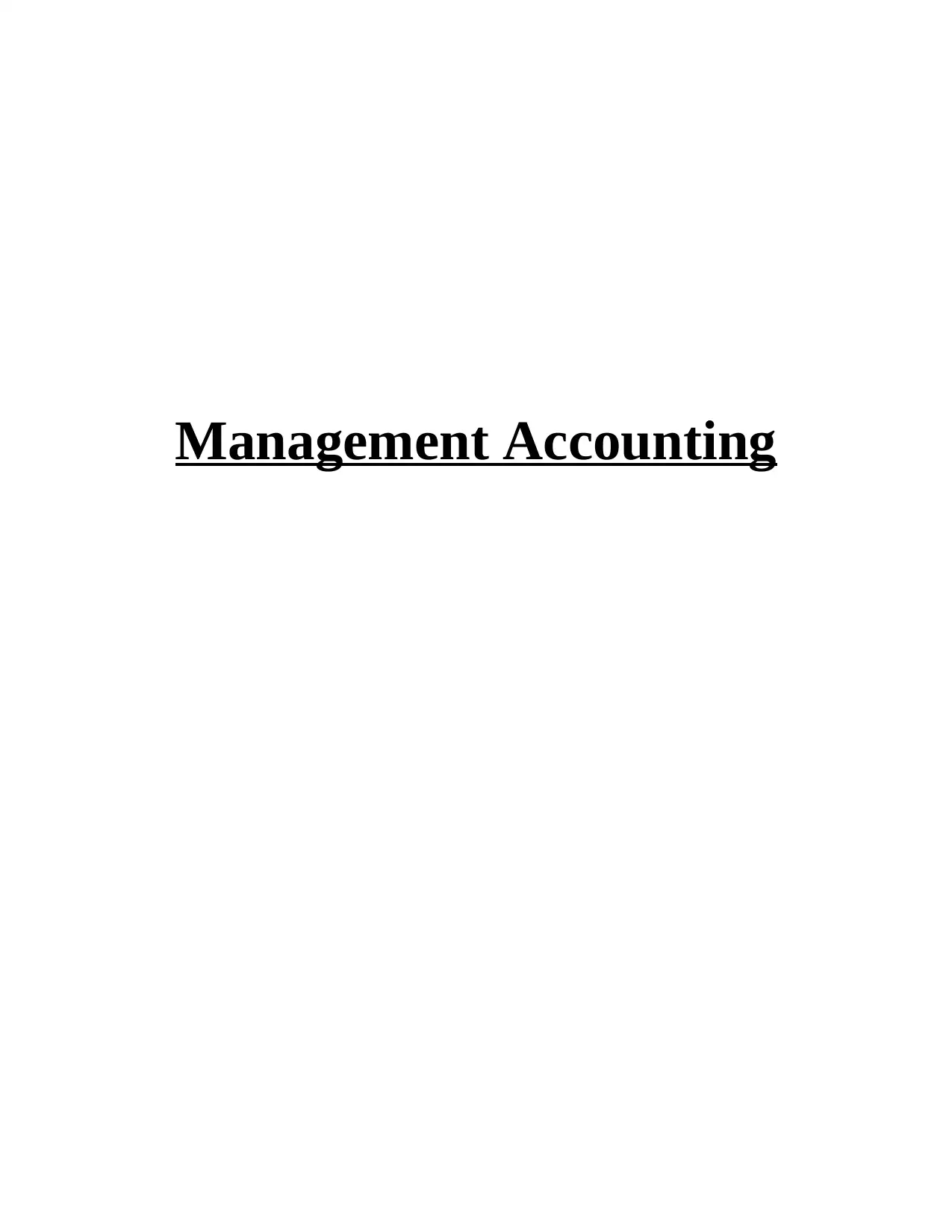
Management Accounting
Paraphrase This Document
Need a fresh take? Get an instant paraphrase of this document with our AI Paraphraser
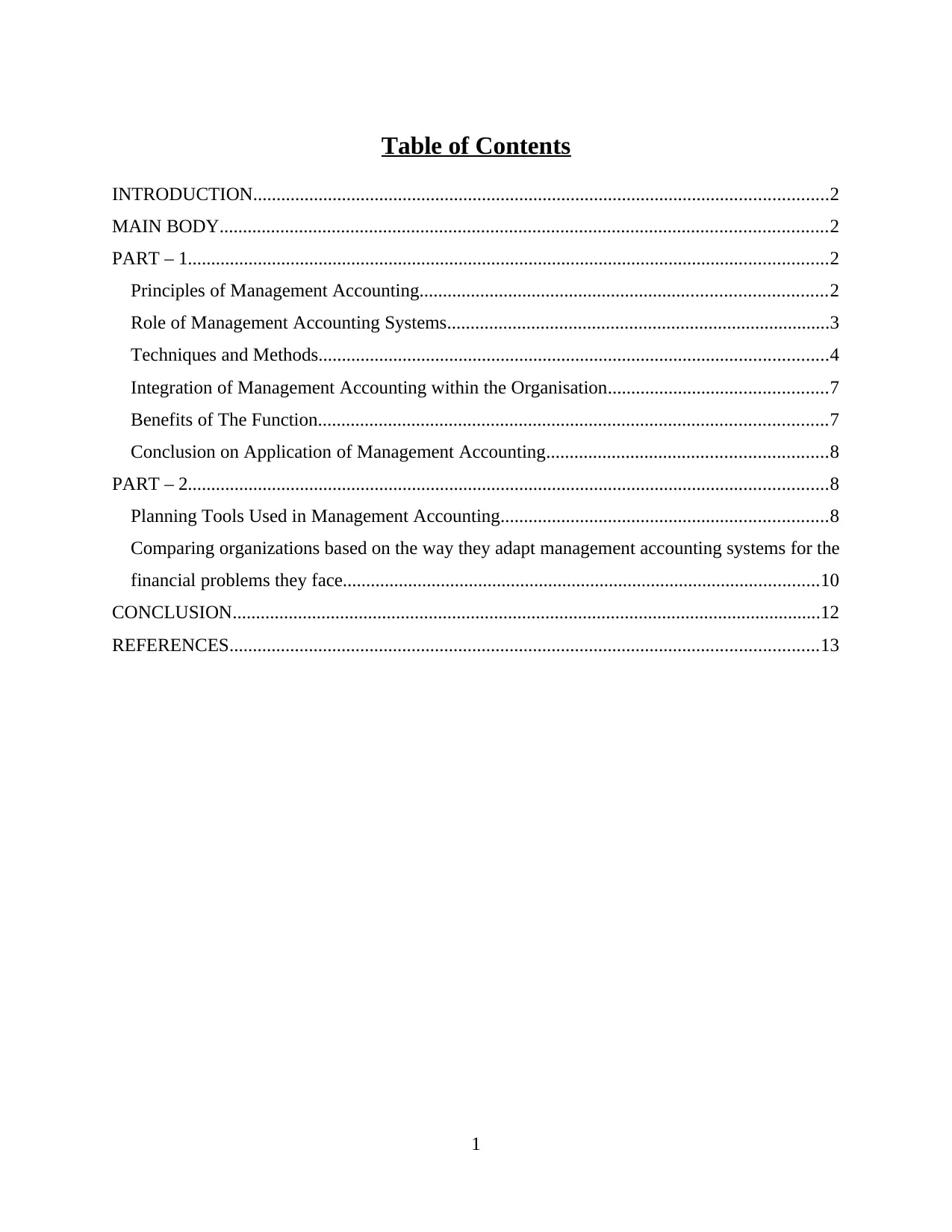
Table of Contents
INTRODUCTION...........................................................................................................................2
MAIN BODY..................................................................................................................................2
PART – 1.........................................................................................................................................2
Principles of Management Accounting.......................................................................................2
Role of Management Accounting Systems..................................................................................3
Techniques and Methods.............................................................................................................4
Integration of Management Accounting within the Organisation...............................................7
Benefits of The Function.............................................................................................................7
Conclusion on Application of Management Accounting............................................................8
PART – 2.........................................................................................................................................8
Planning Tools Used in Management Accounting......................................................................8
Comparing organizations based on the way they adapt management accounting systems for the
financial problems they face......................................................................................................10
CONCLUSION..............................................................................................................................12
REFERENCES..............................................................................................................................13
1
INTRODUCTION...........................................................................................................................2
MAIN BODY..................................................................................................................................2
PART – 1.........................................................................................................................................2
Principles of Management Accounting.......................................................................................2
Role of Management Accounting Systems..................................................................................3
Techniques and Methods.............................................................................................................4
Integration of Management Accounting within the Organisation...............................................7
Benefits of The Function.............................................................................................................7
Conclusion on Application of Management Accounting............................................................8
PART – 2.........................................................................................................................................8
Planning Tools Used in Management Accounting......................................................................8
Comparing organizations based on the way they adapt management accounting systems for the
financial problems they face......................................................................................................10
CONCLUSION..............................................................................................................................12
REFERENCES..............................................................................................................................13
1
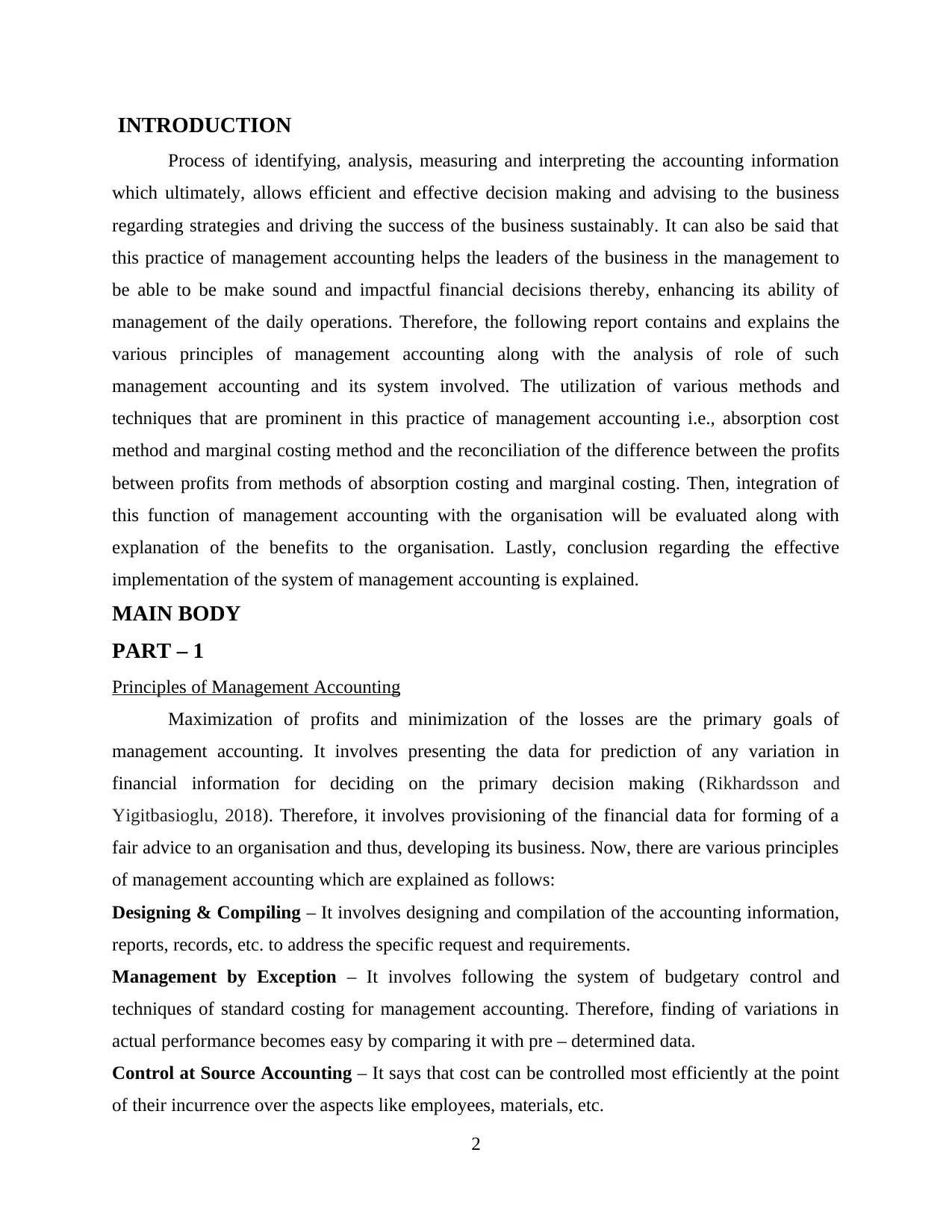
INTRODUCTION
Process of identifying, analysis, measuring and interpreting the accounting information
which ultimately, allows efficient and effective decision making and advising to the business
regarding strategies and driving the success of the business sustainably. It can also be said that
this practice of management accounting helps the leaders of the business in the management to
be able to be make sound and impactful financial decisions thereby, enhancing its ability of
management of the daily operations. Therefore, the following report contains and explains the
various principles of management accounting along with the analysis of role of such
management accounting and its system involved. The utilization of various methods and
techniques that are prominent in this practice of management accounting i.e., absorption cost
method and marginal costing method and the reconciliation of the difference between the profits
between profits from methods of absorption costing and marginal costing. Then, integration of
this function of management accounting with the organisation will be evaluated along with
explanation of the benefits to the organisation. Lastly, conclusion regarding the effective
implementation of the system of management accounting is explained.
MAIN BODY
PART – 1
Principles of Management Accounting
Maximization of profits and minimization of the losses are the primary goals of
management accounting. It involves presenting the data for prediction of any variation in
financial information for deciding on the primary decision making (Rikhardsson and
Yigitbasioglu, 2018). Therefore, it involves provisioning of the financial data for forming of a
fair advice to an organisation and thus, developing its business. Now, there are various principles
of management accounting which are explained as follows:
Designing & Compiling – It involves designing and compilation of the accounting information,
reports, records, etc. to address the specific request and requirements.
Management by Exception – It involves following the system of budgetary control and
techniques of standard costing for management accounting. Therefore, finding of variations in
actual performance becomes easy by comparing it with pre – determined data.
Control at Source Accounting – It says that cost can be controlled most efficiently at the point
of their incurrence over the aspects like employees, materials, etc.
2
Process of identifying, analysis, measuring and interpreting the accounting information
which ultimately, allows efficient and effective decision making and advising to the business
regarding strategies and driving the success of the business sustainably. It can also be said that
this practice of management accounting helps the leaders of the business in the management to
be able to be make sound and impactful financial decisions thereby, enhancing its ability of
management of the daily operations. Therefore, the following report contains and explains the
various principles of management accounting along with the analysis of role of such
management accounting and its system involved. The utilization of various methods and
techniques that are prominent in this practice of management accounting i.e., absorption cost
method and marginal costing method and the reconciliation of the difference between the profits
between profits from methods of absorption costing and marginal costing. Then, integration of
this function of management accounting with the organisation will be evaluated along with
explanation of the benefits to the organisation. Lastly, conclusion regarding the effective
implementation of the system of management accounting is explained.
MAIN BODY
PART – 1
Principles of Management Accounting
Maximization of profits and minimization of the losses are the primary goals of
management accounting. It involves presenting the data for prediction of any variation in
financial information for deciding on the primary decision making (Rikhardsson and
Yigitbasioglu, 2018). Therefore, it involves provisioning of the financial data for forming of a
fair advice to an organisation and thus, developing its business. Now, there are various principles
of management accounting which are explained as follows:
Designing & Compiling – It involves designing and compilation of the accounting information,
reports, records, etc. to address the specific request and requirements.
Management by Exception – It involves following the system of budgetary control and
techniques of standard costing for management accounting. Therefore, finding of variations in
actual performance becomes easy by comparing it with pre – determined data.
Control at Source Accounting – It says that cost can be controlled most efficiently at the point
of their incurrence over the aspects like employees, materials, etc.
2
⊘ This is a preview!⊘
Do you want full access?
Subscribe today to unlock all pages.

Trusted by 1+ million students worldwide
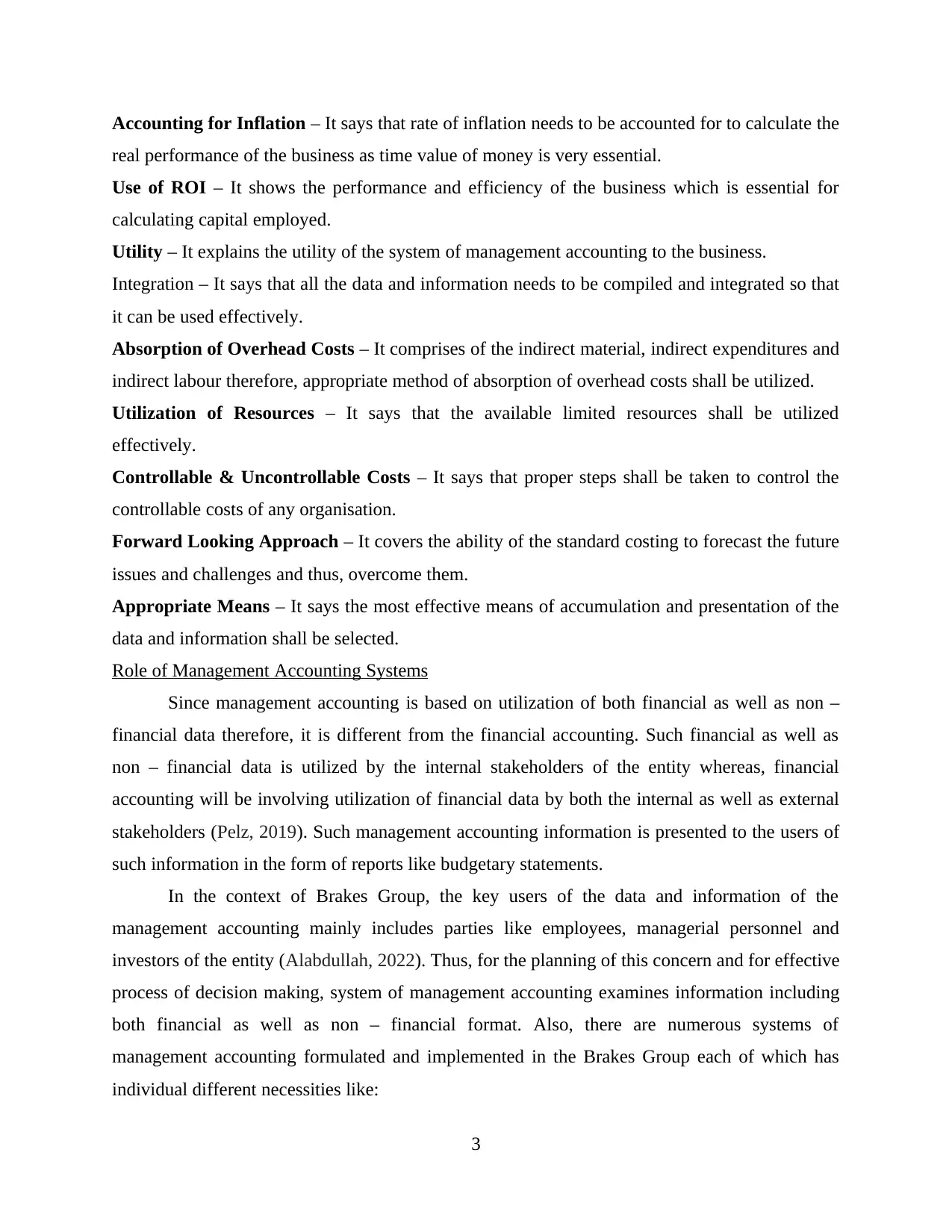
Accounting for Inflation – It says that rate of inflation needs to be accounted for to calculate the
real performance of the business as time value of money is very essential.
Use of ROI – It shows the performance and efficiency of the business which is essential for
calculating capital employed.
Utility – It explains the utility of the system of management accounting to the business.
Integration – It says that all the data and information needs to be compiled and integrated so that
it can be used effectively.
Absorption of Overhead Costs – It comprises of the indirect material, indirect expenditures and
indirect labour therefore, appropriate method of absorption of overhead costs shall be utilized.
Utilization of Resources – It says that the available limited resources shall be utilized
effectively.
Controllable & Uncontrollable Costs – It says that proper steps shall be taken to control the
controllable costs of any organisation.
Forward Looking Approach – It covers the ability of the standard costing to forecast the future
issues and challenges and thus, overcome them.
Appropriate Means – It says the most effective means of accumulation and presentation of the
data and information shall be selected.
Role of Management Accounting Systems
Since management accounting is based on utilization of both financial as well as non –
financial data therefore, it is different from the financial accounting. Such financial as well as
non – financial data is utilized by the internal stakeholders of the entity whereas, financial
accounting will be involving utilization of financial data by both the internal as well as external
stakeholders (Pelz, 2019). Such management accounting information is presented to the users of
such information in the form of reports like budgetary statements.
In the context of Brakes Group, the key users of the data and information of the
management accounting mainly includes parties like employees, managerial personnel and
investors of the entity (Alabdullah, 2022). Thus, for the planning of this concern and for effective
process of decision making, system of management accounting examines information including
both financial as well as non – financial format. Also, there are numerous systems of
management accounting formulated and implemented in the Brakes Group each of which has
individual different necessities like:
3
real performance of the business as time value of money is very essential.
Use of ROI – It shows the performance and efficiency of the business which is essential for
calculating capital employed.
Utility – It explains the utility of the system of management accounting to the business.
Integration – It says that all the data and information needs to be compiled and integrated so that
it can be used effectively.
Absorption of Overhead Costs – It comprises of the indirect material, indirect expenditures and
indirect labour therefore, appropriate method of absorption of overhead costs shall be utilized.
Utilization of Resources – It says that the available limited resources shall be utilized
effectively.
Controllable & Uncontrollable Costs – It says that proper steps shall be taken to control the
controllable costs of any organisation.
Forward Looking Approach – It covers the ability of the standard costing to forecast the future
issues and challenges and thus, overcome them.
Appropriate Means – It says the most effective means of accumulation and presentation of the
data and information shall be selected.
Role of Management Accounting Systems
Since management accounting is based on utilization of both financial as well as non –
financial data therefore, it is different from the financial accounting. Such financial as well as
non – financial data is utilized by the internal stakeholders of the entity whereas, financial
accounting will be involving utilization of financial data by both the internal as well as external
stakeholders (Pelz, 2019). Such management accounting information is presented to the users of
such information in the form of reports like budgetary statements.
In the context of Brakes Group, the key users of the data and information of the
management accounting mainly includes parties like employees, managerial personnel and
investors of the entity (Alabdullah, 2022). Thus, for the planning of this concern and for effective
process of decision making, system of management accounting examines information including
both financial as well as non – financial format. Also, there are numerous systems of
management accounting formulated and implemented in the Brakes Group each of which has
individual different necessities like:
3
Paraphrase This Document
Need a fresh take? Get an instant paraphrase of this document with our AI Paraphraser
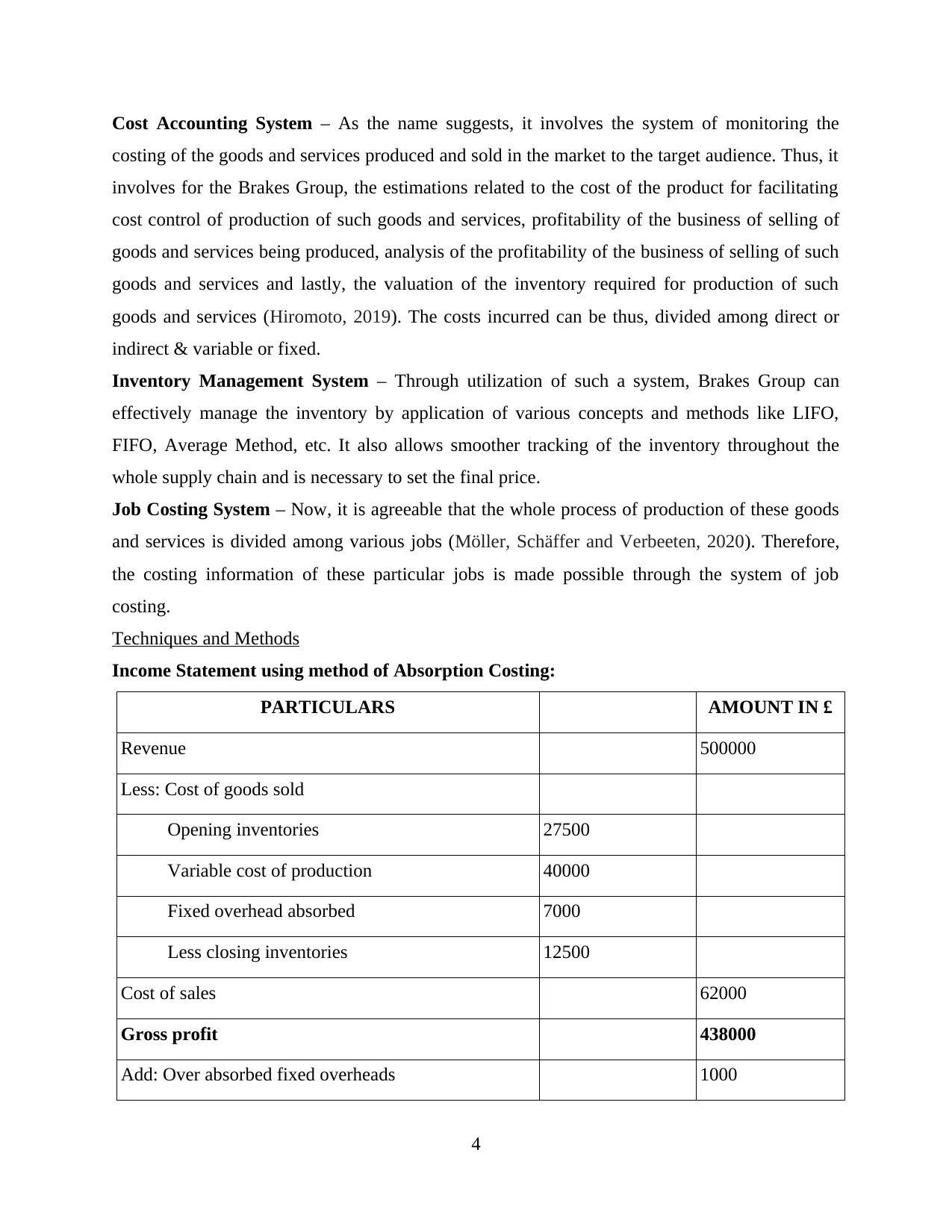
Cost Accounting System – As the name suggests, it involves the system of monitoring the
costing of the goods and services produced and sold in the market to the target audience. Thus, it
involves for the Brakes Group, the estimations related to the cost of the product for facilitating
cost control of production of such goods and services, profitability of the business of selling of
goods and services being produced, analysis of the profitability of the business of selling of such
goods and services and lastly, the valuation of the inventory required for production of such
goods and services (Hiromoto, 2019). The costs incurred can be thus, divided among direct or
indirect & variable or fixed.
Inventory Management System – Through utilization of such a system, Brakes Group can
effectively manage the inventory by application of various concepts and methods like LIFO,
FIFO, Average Method, etc. It also allows smoother tracking of the inventory throughout the
whole supply chain and is necessary to set the final price.
Job Costing System – Now, it is agreeable that the whole process of production of these goods
and services is divided among various jobs (Möller, Schäffer and Verbeeten, 2020). Therefore,
the costing information of these particular jobs is made possible through the system of job
costing.
Techniques and Methods
Income Statement using method of Absorption Costing:
PARTICULARS AMOUNT IN £
Revenue 500000
Less: Cost of goods sold
Opening inventories 27500
Variable cost of production 40000
Fixed overhead absorbed 7000
Less closing inventories 12500
Cost of sales 62000
Gross profit 438000
Add: Over absorbed fixed overheads 1000
4
costing of the goods and services produced and sold in the market to the target audience. Thus, it
involves for the Brakes Group, the estimations related to the cost of the product for facilitating
cost control of production of such goods and services, profitability of the business of selling of
goods and services being produced, analysis of the profitability of the business of selling of such
goods and services and lastly, the valuation of the inventory required for production of such
goods and services (Hiromoto, 2019). The costs incurred can be thus, divided among direct or
indirect & variable or fixed.
Inventory Management System – Through utilization of such a system, Brakes Group can
effectively manage the inventory by application of various concepts and methods like LIFO,
FIFO, Average Method, etc. It also allows smoother tracking of the inventory throughout the
whole supply chain and is necessary to set the final price.
Job Costing System – Now, it is agreeable that the whole process of production of these goods
and services is divided among various jobs (Möller, Schäffer and Verbeeten, 2020). Therefore,
the costing information of these particular jobs is made possible through the system of job
costing.
Techniques and Methods
Income Statement using method of Absorption Costing:
PARTICULARS AMOUNT IN £
Revenue 500000
Less: Cost of goods sold
Opening inventories 27500
Variable cost of production 40000
Fixed overhead absorbed 7000
Less closing inventories 12500
Cost of sales 62000
Gross profit 438000
Add: Over absorbed fixed overheads 1000
4
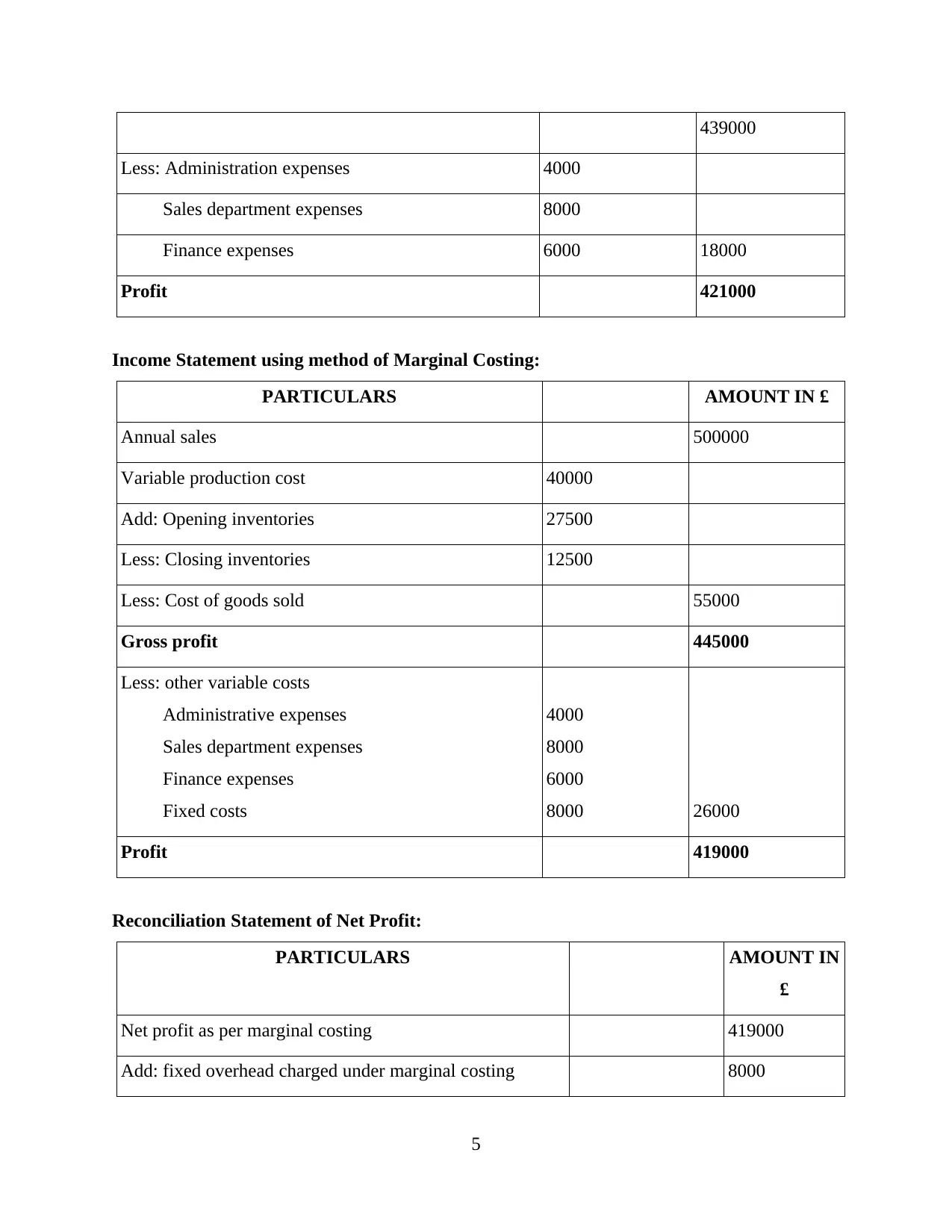
439000
Less: Administration expenses 4000
Sales department expenses 8000
Finance expenses 6000 18000
Profit 421000
Income Statement using method of Marginal Costing:
PARTICULARS AMOUNT IN £
Annual sales 500000
Variable production cost 40000
Add: Opening inventories 27500
Less: Closing inventories 12500
Less: Cost of goods sold 55000
Gross profit 445000
Less: other variable costs
Administrative expenses
Sales department expenses
Finance expenses
Fixed costs
4000
8000
6000
8000 26000
Profit 419000
Reconciliation Statement of Net Profit:
PARTICULARS AMOUNT IN
£
Net profit as per marginal costing 419000
Add: fixed overhead charged under marginal costing 8000
5
Less: Administration expenses 4000
Sales department expenses 8000
Finance expenses 6000 18000
Profit 421000
Income Statement using method of Marginal Costing:
PARTICULARS AMOUNT IN £
Annual sales 500000
Variable production cost 40000
Add: Opening inventories 27500
Less: Closing inventories 12500
Less: Cost of goods sold 55000
Gross profit 445000
Less: other variable costs
Administrative expenses
Sales department expenses
Finance expenses
Fixed costs
4000
8000
6000
8000 26000
Profit 419000
Reconciliation Statement of Net Profit:
PARTICULARS AMOUNT IN
£
Net profit as per marginal costing 419000
Add: fixed overhead charged under marginal costing 8000
5
⊘ This is a preview!⊘
Do you want full access?
Subscribe today to unlock all pages.

Trusted by 1+ million students worldwide
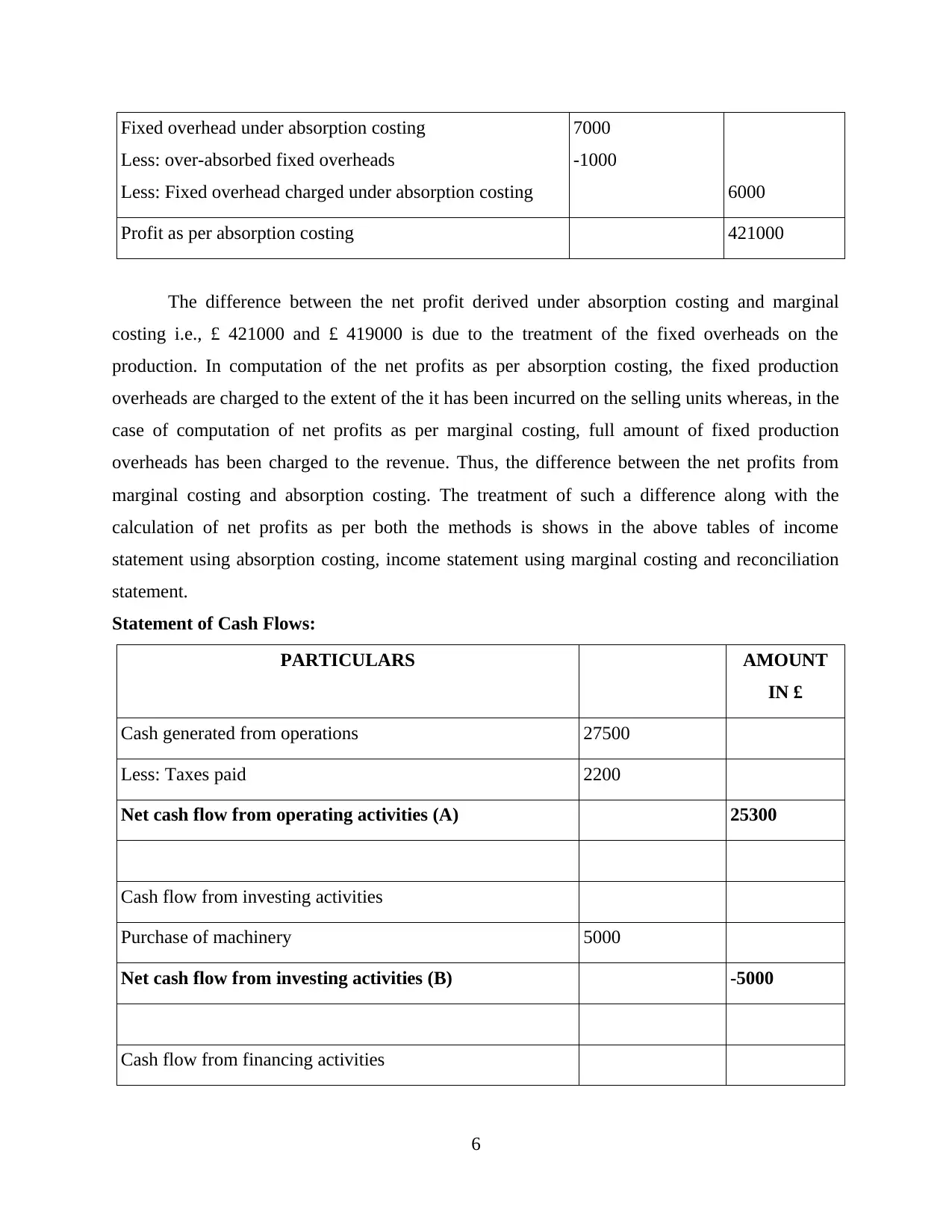
Fixed overhead under absorption costing
Less: over-absorbed fixed overheads
Less: Fixed overhead charged under absorption costing
7000
-1000
6000
Profit as per absorption costing 421000
The difference between the net profit derived under absorption costing and marginal
costing i.e., £ 421000 and £ 419000 is due to the treatment of the fixed overheads on the
production. In computation of the net profits as per absorption costing, the fixed production
overheads are charged to the extent of the it has been incurred on the selling units whereas, in the
case of computation of net profits as per marginal costing, full amount of fixed production
overheads has been charged to the revenue. Thus, the difference between the net profits from
marginal costing and absorption costing. The treatment of such a difference along with the
calculation of net profits as per both the methods is shows in the above tables of income
statement using absorption costing, income statement using marginal costing and reconciliation
statement.
Statement of Cash Flows:
PARTICULARS AMOUNT
IN £
Cash generated from operations 27500
Less: Taxes paid 2200
Net cash flow from operating activities (A) 25300
Cash flow from investing activities
Purchase of machinery 5000
Net cash flow from investing activities (B) -5000
Cash flow from financing activities
6
Less: over-absorbed fixed overheads
Less: Fixed overhead charged under absorption costing
7000
-1000
6000
Profit as per absorption costing 421000
The difference between the net profit derived under absorption costing and marginal
costing i.e., £ 421000 and £ 419000 is due to the treatment of the fixed overheads on the
production. In computation of the net profits as per absorption costing, the fixed production
overheads are charged to the extent of the it has been incurred on the selling units whereas, in the
case of computation of net profits as per marginal costing, full amount of fixed production
overheads has been charged to the revenue. Thus, the difference between the net profits from
marginal costing and absorption costing. The treatment of such a difference along with the
calculation of net profits as per both the methods is shows in the above tables of income
statement using absorption costing, income statement using marginal costing and reconciliation
statement.
Statement of Cash Flows:
PARTICULARS AMOUNT
IN £
Cash generated from operations 27500
Less: Taxes paid 2200
Net cash flow from operating activities (A) 25300
Cash flow from investing activities
Purchase of machinery 5000
Net cash flow from investing activities (B) -5000
Cash flow from financing activities
6
Paraphrase This Document
Need a fresh take? Get an instant paraphrase of this document with our AI Paraphraser
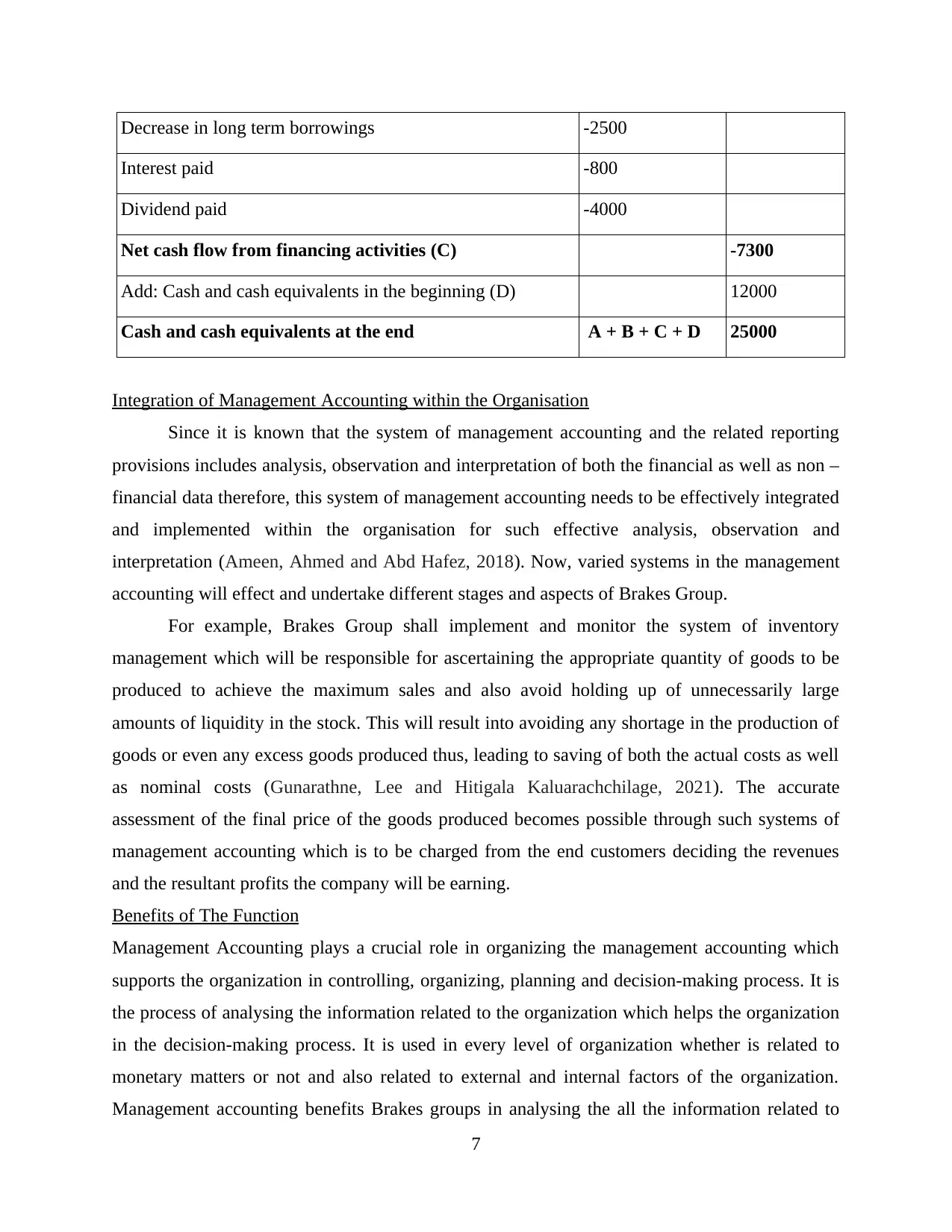
Decrease in long term borrowings -2500
Interest paid -800
Dividend paid -4000
Net cash flow from financing activities (C) -7300
Add: Cash and cash equivalents in the beginning (D) 12000
Cash and cash equivalents at the end A + B + C + D 25000
Integration of Management Accounting within the Organisation
Since it is known that the system of management accounting and the related reporting
provisions includes analysis, observation and interpretation of both the financial as well as non –
financial data therefore, this system of management accounting needs to be effectively integrated
and implemented within the organisation for such effective analysis, observation and
interpretation (Ameen, Ahmed and Abd Hafez, 2018). Now, varied systems in the management
accounting will effect and undertake different stages and aspects of Brakes Group.
For example, Brakes Group shall implement and monitor the system of inventory
management which will be responsible for ascertaining the appropriate quantity of goods to be
produced to achieve the maximum sales and also avoid holding up of unnecessarily large
amounts of liquidity in the stock. This will result into avoiding any shortage in the production of
goods or even any excess goods produced thus, leading to saving of both the actual costs as well
as nominal costs (Gunarathne, Lee and Hitigala Kaluarachchilage, 2021). The accurate
assessment of the final price of the goods produced becomes possible through such systems of
management accounting which is to be charged from the end customers deciding the revenues
and the resultant profits the company will be earning.
Benefits of The Function
Management Accounting plays a crucial role in organizing the management accounting which
supports the organization in controlling, organizing, planning and decision-making process. It is
the process of analysing the information related to the organization which helps the organization
in the decision-making process. It is used in every level of organization whether is related to
monetary matters or not and also related to external and internal factors of the organization.
Management accounting benefits Brakes groups in analysing the all the information related to
7
Interest paid -800
Dividend paid -4000
Net cash flow from financing activities (C) -7300
Add: Cash and cash equivalents in the beginning (D) 12000
Cash and cash equivalents at the end A + B + C + D 25000
Integration of Management Accounting within the Organisation
Since it is known that the system of management accounting and the related reporting
provisions includes analysis, observation and interpretation of both the financial as well as non –
financial data therefore, this system of management accounting needs to be effectively integrated
and implemented within the organisation for such effective analysis, observation and
interpretation (Ameen, Ahmed and Abd Hafez, 2018). Now, varied systems in the management
accounting will effect and undertake different stages and aspects of Brakes Group.
For example, Brakes Group shall implement and monitor the system of inventory
management which will be responsible for ascertaining the appropriate quantity of goods to be
produced to achieve the maximum sales and also avoid holding up of unnecessarily large
amounts of liquidity in the stock. This will result into avoiding any shortage in the production of
goods or even any excess goods produced thus, leading to saving of both the actual costs as well
as nominal costs (Gunarathne, Lee and Hitigala Kaluarachchilage, 2021). The accurate
assessment of the final price of the goods produced becomes possible through such systems of
management accounting which is to be charged from the end customers deciding the revenues
and the resultant profits the company will be earning.
Benefits of The Function
Management Accounting plays a crucial role in organizing the management accounting which
supports the organization in controlling, organizing, planning and decision-making process. It is
the process of analysing the information related to the organization which helps the organization
in the decision-making process. It is used in every level of organization whether is related to
monetary matters or not and also related to external and internal factors of the organization.
Management accounting benefits Brakes groups in analysing the all the information related to
7
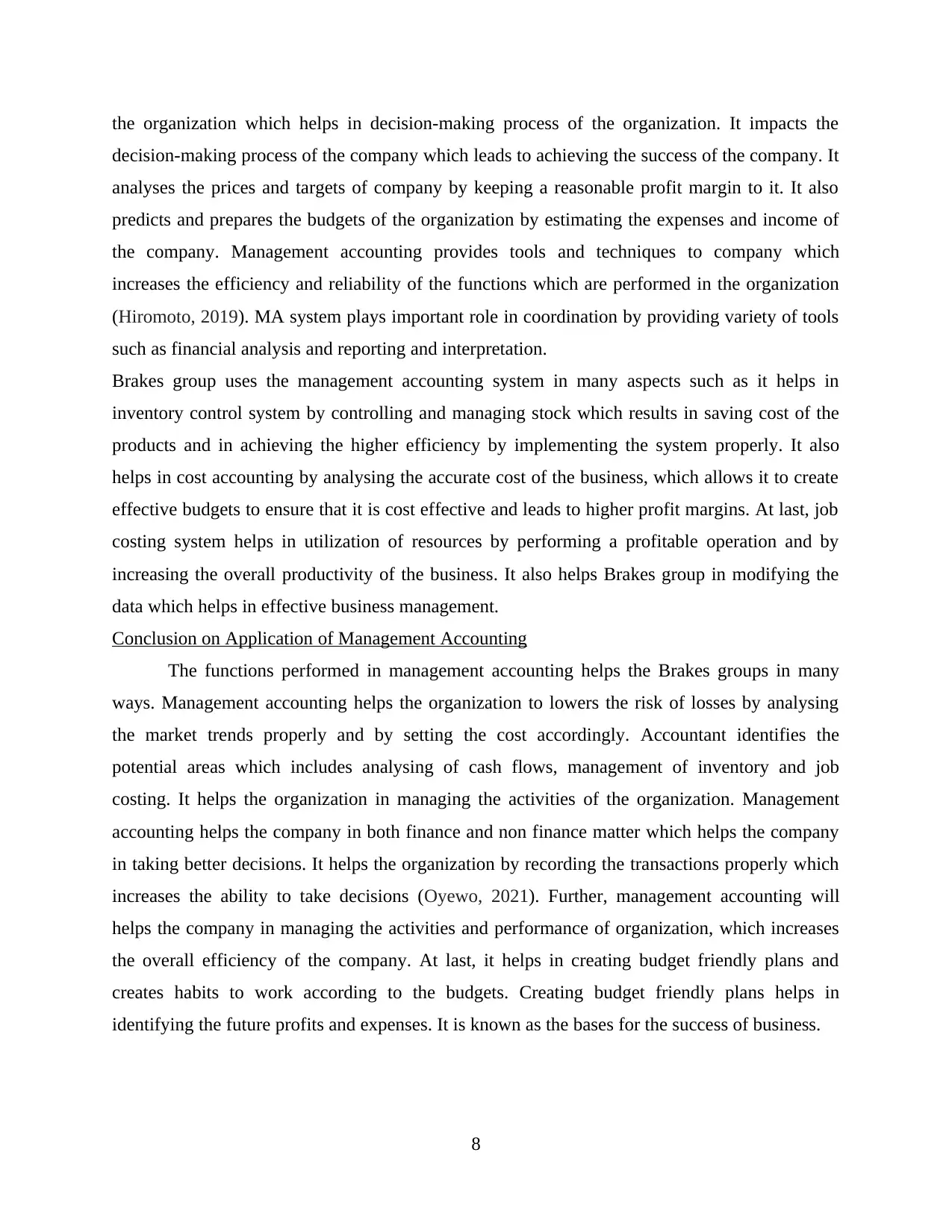
the organization which helps in decision-making process of the organization. It impacts the
decision-making process of the company which leads to achieving the success of the company. It
analyses the prices and targets of company by keeping a reasonable profit margin to it. It also
predicts and prepares the budgets of the organization by estimating the expenses and income of
the company. Management accounting provides tools and techniques to company which
increases the efficiency and reliability of the functions which are performed in the organization
(Hiromoto, 2019). MA system plays important role in coordination by providing variety of tools
such as financial analysis and reporting and interpretation.
Brakes group uses the management accounting system in many aspects such as it helps in
inventory control system by controlling and managing stock which results in saving cost of the
products and in achieving the higher efficiency by implementing the system properly. It also
helps in cost accounting by analysing the accurate cost of the business, which allows it to create
effective budgets to ensure that it is cost effective and leads to higher profit margins. At last, job
costing system helps in utilization of resources by performing a profitable operation and by
increasing the overall productivity of the business. It also helps Brakes group in modifying the
data which helps in effective business management.
Conclusion on Application of Management Accounting
The functions performed in management accounting helps the Brakes groups in many
ways. Management accounting helps the organization to lowers the risk of losses by analysing
the market trends properly and by setting the cost accordingly. Accountant identifies the
potential areas which includes analysing of cash flows, management of inventory and job
costing. It helps the organization in managing the activities of the organization. Management
accounting helps the company in both finance and non finance matter which helps the company
in taking better decisions. It helps the organization by recording the transactions properly which
increases the ability to take decisions (Oyewo, 2021). Further, management accounting will
helps the company in managing the activities and performance of organization, which increases
the overall efficiency of the company. At last, it helps in creating budget friendly plans and
creates habits to work according to the budgets. Creating budget friendly plans helps in
identifying the future profits and expenses. It is known as the bases for the success of business.
8
decision-making process of the company which leads to achieving the success of the company. It
analyses the prices and targets of company by keeping a reasonable profit margin to it. It also
predicts and prepares the budgets of the organization by estimating the expenses and income of
the company. Management accounting provides tools and techniques to company which
increases the efficiency and reliability of the functions which are performed in the organization
(Hiromoto, 2019). MA system plays important role in coordination by providing variety of tools
such as financial analysis and reporting and interpretation.
Brakes group uses the management accounting system in many aspects such as it helps in
inventory control system by controlling and managing stock which results in saving cost of the
products and in achieving the higher efficiency by implementing the system properly. It also
helps in cost accounting by analysing the accurate cost of the business, which allows it to create
effective budgets to ensure that it is cost effective and leads to higher profit margins. At last, job
costing system helps in utilization of resources by performing a profitable operation and by
increasing the overall productivity of the business. It also helps Brakes group in modifying the
data which helps in effective business management.
Conclusion on Application of Management Accounting
The functions performed in management accounting helps the Brakes groups in many
ways. Management accounting helps the organization to lowers the risk of losses by analysing
the market trends properly and by setting the cost accordingly. Accountant identifies the
potential areas which includes analysing of cash flows, management of inventory and job
costing. It helps the organization in managing the activities of the organization. Management
accounting helps the company in both finance and non finance matter which helps the company
in taking better decisions. It helps the organization by recording the transactions properly which
increases the ability to take decisions (Oyewo, 2021). Further, management accounting will
helps the company in managing the activities and performance of organization, which increases
the overall efficiency of the company. At last, it helps in creating budget friendly plans and
creates habits to work according to the budgets. Creating budget friendly plans helps in
identifying the future profits and expenses. It is known as the bases for the success of business.
8
⊘ This is a preview!⊘
Do you want full access?
Subscribe today to unlock all pages.

Trusted by 1+ million students worldwide
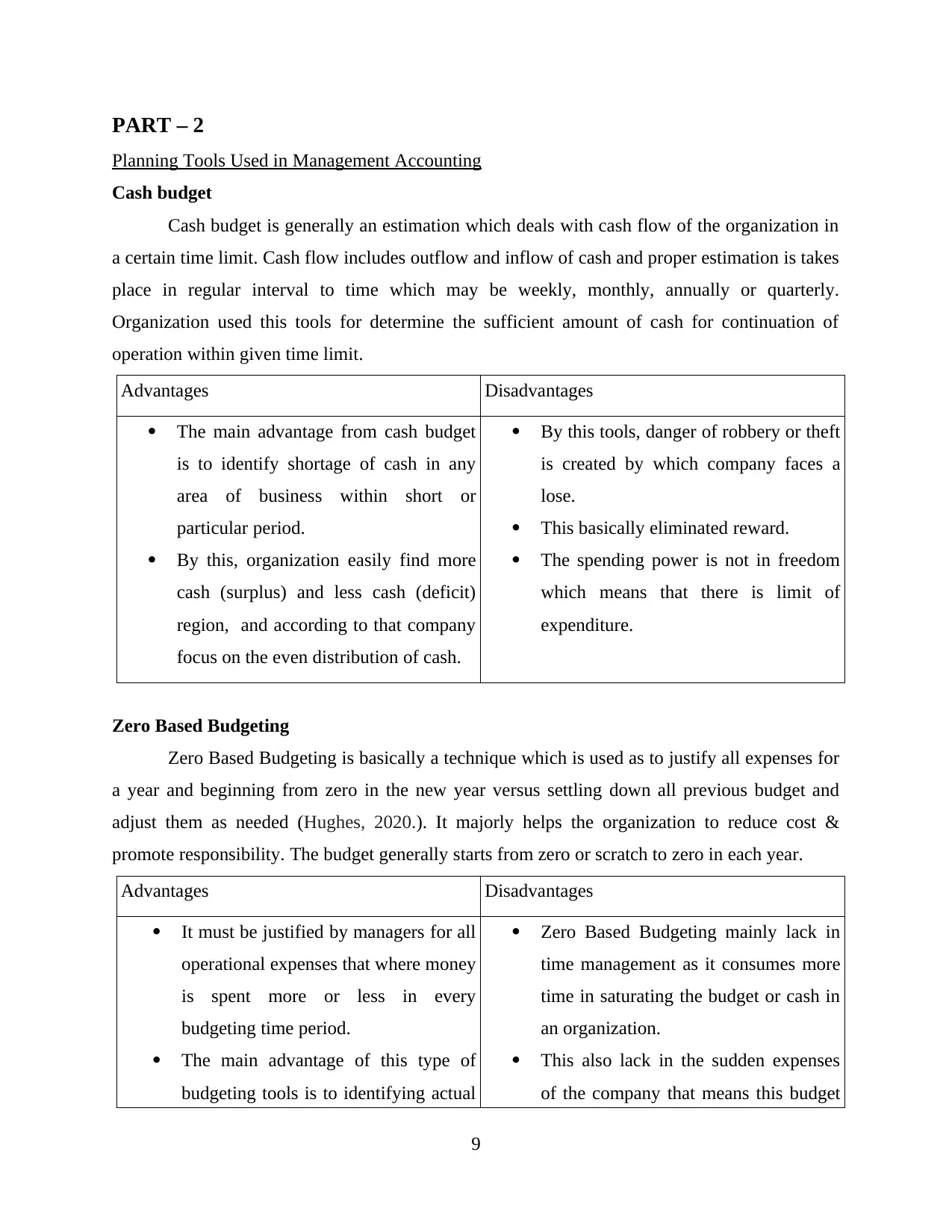
PART – 2
Planning Tools Used in Management Accounting
Cash budget
Cash budget is generally an estimation which deals with cash flow of the organization in
a certain time limit. Cash flow includes outflow and inflow of cash and proper estimation is takes
place in regular interval to time which may be weekly, monthly, annually or quarterly.
Organization used this tools for determine the sufficient amount of cash for continuation of
operation within given time limit.
Advantages Disadvantages
The main advantage from cash budget
is to identify shortage of cash in any
area of business within short or
particular period.
By this, organization easily find more
cash (surplus) and less cash (deficit)
region, and according to that company
focus on the even distribution of cash.
By this tools, danger of robbery or theft
is created by which company faces a
lose.
This basically eliminated reward.
The spending power is not in freedom
which means that there is limit of
expenditure.
Zero Based Budgeting
Zero Based Budgeting is basically a technique which is used as to justify all expenses for
a year and beginning from zero in the new year versus settling down all previous budget and
adjust them as needed (Hughes, 2020.). It majorly helps the organization to reduce cost &
promote responsibility. The budget generally starts from zero or scratch to zero in each year.
Advantages Disadvantages
It must be justified by managers for all
operational expenses that where money
is spent more or less in every
budgeting time period.
The main advantage of this type of
budgeting tools is to identifying actual
Zero Based Budgeting mainly lack in
time management as it consumes more
time in saturating the budget or cash in
an organization.
This also lack in the sudden expenses
of the company that means this budget
9
Planning Tools Used in Management Accounting
Cash budget
Cash budget is generally an estimation which deals with cash flow of the organization in
a certain time limit. Cash flow includes outflow and inflow of cash and proper estimation is takes
place in regular interval to time which may be weekly, monthly, annually or quarterly.
Organization used this tools for determine the sufficient amount of cash for continuation of
operation within given time limit.
Advantages Disadvantages
The main advantage from cash budget
is to identify shortage of cash in any
area of business within short or
particular period.
By this, organization easily find more
cash (surplus) and less cash (deficit)
region, and according to that company
focus on the even distribution of cash.
By this tools, danger of robbery or theft
is created by which company faces a
lose.
This basically eliminated reward.
The spending power is not in freedom
which means that there is limit of
expenditure.
Zero Based Budgeting
Zero Based Budgeting is basically a technique which is used as to justify all expenses for
a year and beginning from zero in the new year versus settling down all previous budget and
adjust them as needed (Hughes, 2020.). It majorly helps the organization to reduce cost &
promote responsibility. The budget generally starts from zero or scratch to zero in each year.
Advantages Disadvantages
It must be justified by managers for all
operational expenses that where money
is spent more or less in every
budgeting time period.
The main advantage of this type of
budgeting tools is to identifying actual
Zero Based Budgeting mainly lack in
time management as it consumes more
time in saturating the budget or cash in
an organization.
This also lack in the sudden expenses
of the company that means this budget
9
Paraphrase This Document
Need a fresh take? Get an instant paraphrase of this document with our AI Paraphraser
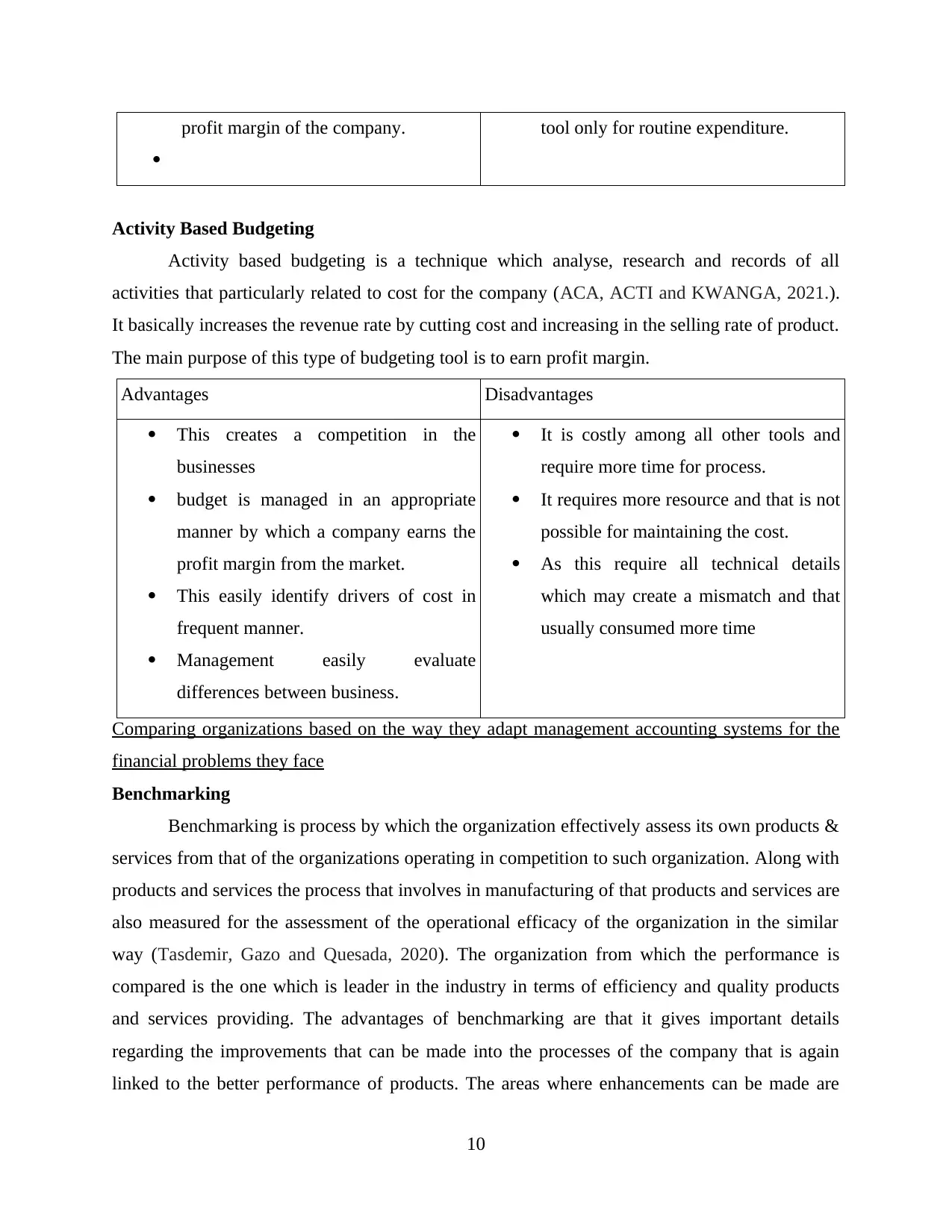
profit margin of the company.
tool only for routine expenditure.
Activity Based Budgeting
Activity based budgeting is a technique which analyse, research and records of all
activities that particularly related to cost for the company (ACA, ACTI and KWANGA, 2021.).
It basically increases the revenue rate by cutting cost and increasing in the selling rate of product.
The main purpose of this type of budgeting tool is to earn profit margin.
Advantages Disadvantages
This creates a competition in the
businesses
budget is managed in an appropriate
manner by which a company earns the
profit margin from the market.
This easily identify drivers of cost in
frequent manner.
Management easily evaluate
differences between business.
It is costly among all other tools and
require more time for process.
It requires more resource and that is not
possible for maintaining the cost.
As this require all technical details
which may create a mismatch and that
usually consumed more time
Comparing organizations based on the way they adapt management accounting systems for the
financial problems they face
Benchmarking
Benchmarking is process by which the organization effectively assess its own products &
services from that of the organizations operating in competition to such organization. Along with
products and services the process that involves in manufacturing of that products and services are
also measured for the assessment of the operational efficacy of the organization in the similar
way (Tasdemir, Gazo and Quesada, 2020). The organization from which the performance is
compared is the one which is leader in the industry in terms of efficiency and quality products
and services providing. The advantages of benchmarking are that it gives important details
regarding the improvements that can be made into the processes of the company that is again
linked to the better performance of products. The areas where enhancements can be made are
10
tool only for routine expenditure.
Activity Based Budgeting
Activity based budgeting is a technique which analyse, research and records of all
activities that particularly related to cost for the company (ACA, ACTI and KWANGA, 2021.).
It basically increases the revenue rate by cutting cost and increasing in the selling rate of product.
The main purpose of this type of budgeting tool is to earn profit margin.
Advantages Disadvantages
This creates a competition in the
businesses
budget is managed in an appropriate
manner by which a company earns the
profit margin from the market.
This easily identify drivers of cost in
frequent manner.
Management easily evaluate
differences between business.
It is costly among all other tools and
require more time for process.
It requires more resource and that is not
possible for maintaining the cost.
As this require all technical details
which may create a mismatch and that
usually consumed more time
Comparing organizations based on the way they adapt management accounting systems for the
financial problems they face
Benchmarking
Benchmarking is process by which the organization effectively assess its own products &
services from that of the organizations operating in competition to such organization. Along with
products and services the process that involves in manufacturing of that products and services are
also measured for the assessment of the operational efficacy of the organization in the similar
way (Tasdemir, Gazo and Quesada, 2020). The organization from which the performance is
compared is the one which is leader in the industry in terms of efficiency and quality products
and services providing. The advantages of benchmarking are that it gives important details
regarding the improvements that can be made into the processes of the company that is again
linked to the better performance of products. The areas where enhancements can be made are
10
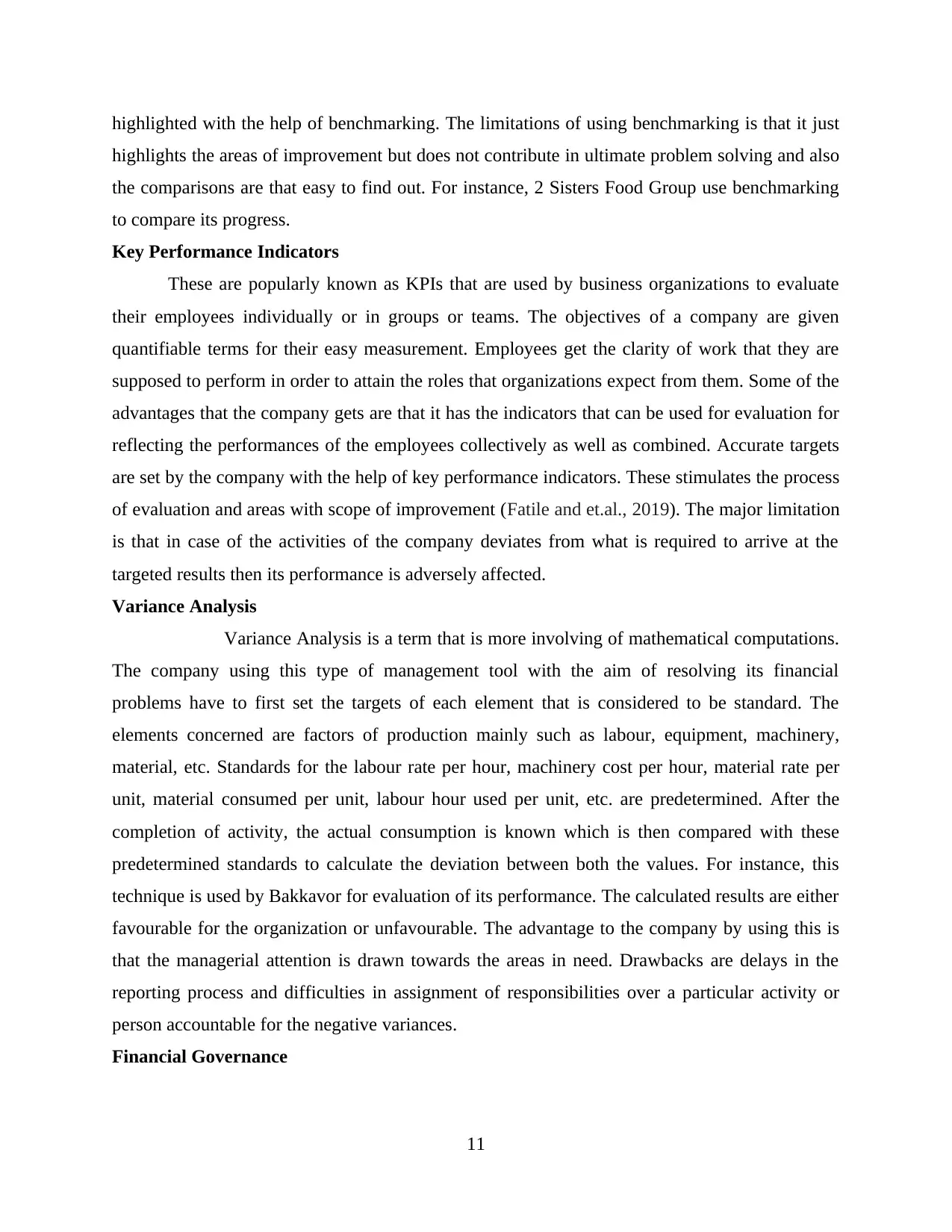
highlighted with the help of benchmarking. The limitations of using benchmarking is that it just
highlights the areas of improvement but does not contribute in ultimate problem solving and also
the comparisons are that easy to find out. For instance, 2 Sisters Food Group use benchmarking
to compare its progress.
Key Performance Indicators
These are popularly known as KPIs that are used by business organizations to evaluate
their employees individually or in groups or teams. The objectives of a company are given
quantifiable terms for their easy measurement. Employees get the clarity of work that they are
supposed to perform in order to attain the roles that organizations expect from them. Some of the
advantages that the company gets are that it has the indicators that can be used for evaluation for
reflecting the performances of the employees collectively as well as combined. Accurate targets
are set by the company with the help of key performance indicators. These stimulates the process
of evaluation and areas with scope of improvement (Fatile and et.al., 2019). The major limitation
is that in case of the activities of the company deviates from what is required to arrive at the
targeted results then its performance is adversely affected.
Variance Analysis
Variance Analysis is a term that is more involving of mathematical computations.
The company using this type of management tool with the aim of resolving its financial
problems have to first set the targets of each element that is considered to be standard. The
elements concerned are factors of production mainly such as labour, equipment, machinery,
material, etc. Standards for the labour rate per hour, machinery cost per hour, material rate per
unit, material consumed per unit, labour hour used per unit, etc. are predetermined. After the
completion of activity, the actual consumption is known which is then compared with these
predetermined standards to calculate the deviation between both the values. For instance, this
technique is used by Bakkavor for evaluation of its performance. The calculated results are either
favourable for the organization or unfavourable. The advantage to the company by using this is
that the managerial attention is drawn towards the areas in need. Drawbacks are delays in the
reporting process and difficulties in assignment of responsibilities over a particular activity or
person accountable for the negative variances.
Financial Governance
11
highlights the areas of improvement but does not contribute in ultimate problem solving and also
the comparisons are that easy to find out. For instance, 2 Sisters Food Group use benchmarking
to compare its progress.
Key Performance Indicators
These are popularly known as KPIs that are used by business organizations to evaluate
their employees individually or in groups or teams. The objectives of a company are given
quantifiable terms for their easy measurement. Employees get the clarity of work that they are
supposed to perform in order to attain the roles that organizations expect from them. Some of the
advantages that the company gets are that it has the indicators that can be used for evaluation for
reflecting the performances of the employees collectively as well as combined. Accurate targets
are set by the company with the help of key performance indicators. These stimulates the process
of evaluation and areas with scope of improvement (Fatile and et.al., 2019). The major limitation
is that in case of the activities of the company deviates from what is required to arrive at the
targeted results then its performance is adversely affected.
Variance Analysis
Variance Analysis is a term that is more involving of mathematical computations.
The company using this type of management tool with the aim of resolving its financial
problems have to first set the targets of each element that is considered to be standard. The
elements concerned are factors of production mainly such as labour, equipment, machinery,
material, etc. Standards for the labour rate per hour, machinery cost per hour, material rate per
unit, material consumed per unit, labour hour used per unit, etc. are predetermined. After the
completion of activity, the actual consumption is known which is then compared with these
predetermined standards to calculate the deviation between both the values. For instance, this
technique is used by Bakkavor for evaluation of its performance. The calculated results are either
favourable for the organization or unfavourable. The advantage to the company by using this is
that the managerial attention is drawn towards the areas in need. Drawbacks are delays in the
reporting process and difficulties in assignment of responsibilities over a particular activity or
person accountable for the negative variances.
Financial Governance
11
⊘ This is a preview!⊘
Do you want full access?
Subscribe today to unlock all pages.

Trusted by 1+ million students worldwide
1 out of 15
Related Documents
Your All-in-One AI-Powered Toolkit for Academic Success.
+13062052269
info@desklib.com
Available 24*7 on WhatsApp / Email
![[object Object]](/_next/static/media/star-bottom.7253800d.svg)
Unlock your academic potential
Copyright © 2020–2025 A2Z Services. All Rights Reserved. Developed and managed by ZUCOL.





